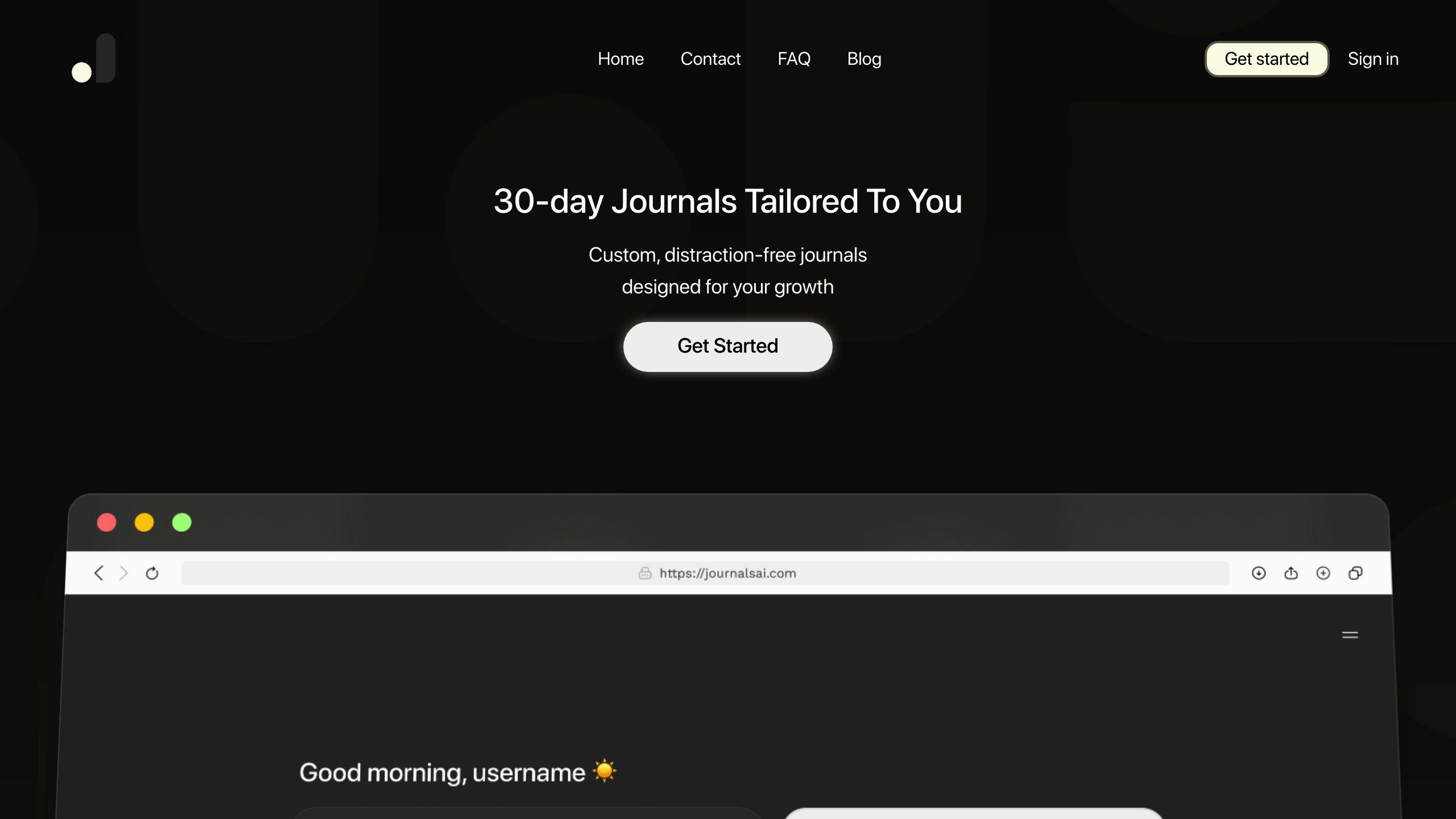Overcoming Writer's Block: Journal Writing Solutions

Over 42% of writers face writer's block, often caused by stress, perfectionism, or external pressures. Journaling is a simple way to overcome this by clearing mental blocks, reducing anxiety, and sparking creativity. Here’s how you can start:
- Freewriting: Write nonstop for 10–15 minutes without editing or judging. This helps quiet self-criticism.
- Prompt-Based Journaling: Use structured prompts, like "What’s a challenge you’ve turned into an opportunity?" to kickstart ideas.
- Mindfulness: Combine journaling with deep breaths and focus on current thoughts to ease stress.
AI tools like Mindsera and JournalsAI can enhance your journaling by offering personalized prompts, analyzing patterns, and providing actionable insights. A mix of traditional methods and AI support can help you build a consistent writing habit and break through creative barriers. Start with just 15 minutes a day to see results.
What Causes Writer's Block?
What Is Writer's Block?
Writer's block happens when writers - no matter their skill level - struggle to come up with new ideas or put their thoughts into words. Some common reasons behind this include:
- Stress and Mental Fatigue: Anxiety, stress, or feeling drained can make it hard to think clearly or stay creative.
- Perfectionism: Trying to get everything right on the first try often leads to overthinking and getting stuck.
- External Pressures: Tight deadlines, high expectations, or fear of criticism can make writing feel overwhelming.
Identifying these triggers is key to figuring out how journaling can help overcome them.
The Impact on Creativity
Writer's block affects both the creative process and overall well-being. Here's how:
| Area | Impact on Writing | Impact on Well-being |
|---|---|---|
| Thinking Clearly | Trouble organizing thoughts | Mental exhaustion |
| Generating Ideas | Ideas feel forced or absent | Confidence takes a hit |
These challenges often lead to what experts call a "creativity-blocking cycle" [3]. Small doubts can grow into a bigger fear of failure, causing avoidance and making it even harder to break free.
By understanding what’s causing the block, you can pick journaling techniques that address your specific struggle. For example, if perfectionism is holding you back, freewriting might help you let go of the need for flawless work. On the other hand, if stress is the issue, mindfulness exercises paired with journaling could recharge your creativity [1].
Knowing what’s behind writer's block is the first step toward finding solutions that work for you.
Journaling Methods to Break Through
Writing Freely Without Rules
Freewriting is all about letting your thoughts flow onto the page without stopping to edit or judge. Spend 10–15 minutes writing whatever comes to mind. Studies suggest this approach helps clear mental blocks and spark new ideas by quieting self-criticism and easing stress [5]. It's a simple way to tap into your natural creativity and let go of perfectionism.
Using Prompt-Based Journaling
AI tools have made journaling prompts more engaging and tailored to individual needs. These prompts offer a structured way to kick off your writing and tackle specific challenges. Here are a few examples:
| Prompt Type | Example Prompt |
|---|---|
| Reflection | "Describe a recent challenge that sparked creativity." |
| Exploration | "Write about a skill you'd like to master." |
| Problem-solving | "List three alternative approaches to your current project." |
Platforms like Mindsera take it a step further, offering prompts that adjust to your writing style and emotional state [4]. These tools keep things fresh and help you stay consistent, avoiding the monotony of generic cues.
Mindfulness in Journaling
Adding mindfulness to your journaling can reduce stress and boost creativity. The idea is to stay present with your thoughts and emotions as you write, instead of focusing on productivity.
Start by taking three deep breaths, notice how you're feeling, and then write about your current thoughts and emotions. This approach is particularly helpful for tackling stress-induced writer's block [1]. By blending mindfulness with writing, you create a space for ideas to emerge naturally, without pressure.
Consistency is important, but don't be too rigid. Over time, you'll start to notice when your creativity flows best, making it easier to plan your writing sessions. Pairing these techniques with AI tools can make your journaling even more effective, helping you break through creative barriers.
Overcoming Writers Block: Unleashing Your Creativity Through Free Writing
How AI Can Improve Journaling
Traditional journaling methods like freewriting and prompts work well, but AI tools can elevate the experience by offering more tailored and interactive solutions.
How AI-Generated Prompts Work
AI journaling tools create prompts specifically designed for you by analyzing your writing style, past entries, and even your emotional tone. These suggestions adjust to your needs, making it easier to overcome creative blocks. For example, Mindsera uses smart buttons to generate context-based questions as you write, helping you see things from new angles when you feel stuck [4].
Let AI Analyze Your Writing
AI tools can dig into your journal entries to uncover recurring themes, emotional patterns, and potential causes of writer's block. These insights can give you a deeper understanding of your habits and areas for growth. Mindsera, for instance, turns your journal into actionable insights, pointing out where you can improve and grow [4].
What Makes JournalsAI Stand Out?

JournalsAI blends AI-powered analysis with practical features to make journaling easier and more impactful. It provides personalized journaling paths, evolving prompts, and a distraction-free space for writing - all while ensuring your privacy with end-to-end encryption.
Here’s what JournalsAI offers:
- Custom 30-day journaling paths to keep you on track
- AI-generated prompts that adapt as you progress
- A focused, distraction-free writing environment
- Built-in knowledge tools to support your entries
You can try JournalsAI for free for 7 days, with subscriptions starting at $9/month or $99/year.
Making Journaling a Daily Practice
Journaling regularly can help you push past writer's block by creating a steady rhythm for your thoughts and lowering mental hurdles that block creativity.
Sticking to a Journaling Routine
Writing consistently can ease stress and anxiety, which are common triggers for writer's block [1][3]. A set routine helps break down mental barriers by creating predictable habits.
- Set a Dedicated Time: Pick a time that fits your schedule - mornings for fresh ideas, midday to decompress, or evenings for reflection. Aim for at least 15 minutes of focused writing [5].
- Create a Focused Environment: Choose a quiet space, whether physical or digital. Tools like Diaro provide a distraction-free digital journaling option [2]. This separation helps your brain recognize when it's time to write.
Blending AI Tools with Other Methods
Using a mix of traditional journaling and AI tools can give you the best of both worlds: free-flowing creativity and structured insights. This combination can help you tackle mental blocks more effectively.
- Start with Traditional Methods: Begin by freewriting to let your thoughts flow naturally. This sets the stage for deeper exploration when you bring in AI tools later.
- Enhance with AI Support: Use AI tools to guide and inspire you, not to take over. These tools can help spot patterns or suggest fresh ideas when you're feeling stuck, while you keep the personal touch intact.
"Journaling can be a space where your ideas flow freely and take priority over deciding how to phrase each point you're trying to make." - Acadia Editing [6]
Conclusion
Journaling, paired with consistent effort and modern tools, offers a practical way to tackle writer's block. Whether you lean on classic methods or take advantage of AI-powered tools, there are plenty of options to break through creative barriers and keep your writing routine on track.
Journaling provides a space free from judgment, helping to lower the mental walls that often lead to creative blocks. Tools like Notion and DayOne add a modern twist, offering prompts and insights that go beyond what traditional methods can provide, all while keeping the process personal [2].
Studies highlight that regular journaling boosts both productivity and creative flow. A mix of freewriting, mindfulness exercises, and AI-generated prompts can create a well-rounded approach to overcoming writer’s block. Whether you prefer the simplicity of freewriting or the structure of AI prompts, the key lies in sticking with it and finding what works for you.
By setting aside just 15 minutes a day for journaling [5], you can build a habit that not only helps with current challenges but also keeps future creative slumps at bay. Modern tools blend human creativity with tech support, making the process smoother and more effective.
The focus isn’t on perfection - it’s about progress. Start with what feels natural, and as you go, you’ll find the right mix of techniques that fit your writing style and needs. Journaling can be a stepping stone to rediscovering your creative flow, so grab a notebook or open an app, and let the words begin to pour.
FAQs
What is AI journaling?
AI journaling combines technology with traditional journaling by offering personalized prompts and insights based on your writing style and mood [2][4]. These tools can spot patterns in your entries and suggest exercises to help you stay consistent and move past creative blocks.
How do AI-powered journaling tools work?
These tools analyze your writing to create prompts and insights that inspire creativity. For instance, Mindsera reviews your journal entries, reflects on your thoughts, and suggests actionable steps to turn your ideas into writing [4]. Over time, the system learns your style, offering increasingly tailored suggestions to tackle creative challenges.
Can AI journaling replace traditional methods?
AI journaling is most effective when paired with traditional practices rather than replacing them [1][3]. While AI tools provide structure and guidance, combining them with freewriting or mindfulness exercises offers a more balanced way to overcome writer's block. This approach blends tech-driven support with natural creative flow.
What makes AI journaling effective for writer's block?
AI journaling helps tackle challenges like perfectionism and performance anxiety [1][3]. By offering structured prompts and minimizing decision fatigue, these tools create a space where you can write freely without judgment.
"AI journaling can be a powerful tool in overcoming writer's block by providing structured and engaging writing activities that address deeper psychological issues. AI journaling can help in maintaining a consistent writing habit, fostering creativity, and enhancing overall writing productivity" [1][3].
